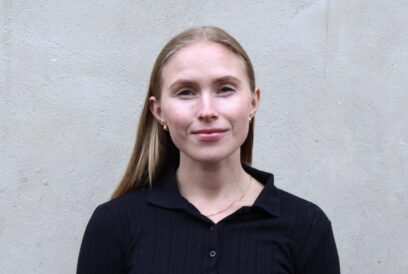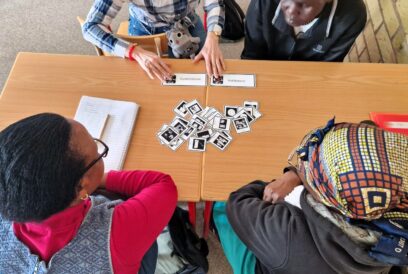
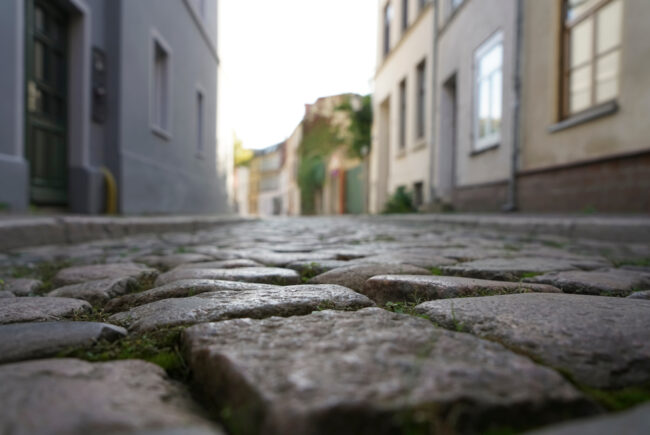
Walking is a way to be a part of the city, procreate public space and enable spontaneous encounters. Photo credit: Shutterstock
Walking is a way to be a part of the city, procreate public space and enable spontaneous encounters. Photo credit: Shutterstock
Walking in the city is about much more than just getting from A to B.
I find myself shivering at a street corner on a chilly spring day, and realise that I should have put on warmer clothes.
However, as Eila Lokka begins to unveil the history of the jugendstil buildings of my home town, I quickly forget the distractions.
I learn of a prominent female architect, Wivi Lönn, who shook up the field of architecture (considered to be a profession for men in the early 20th century) by winning a design competition for the new central fire station of Tampere.
I am attending an architecture walk for freelance journalists, designed to promote health and well-being. This it certainly does: walking around in fresh air with colleagues is a welcome break to the daily routine, which most of the time means sitting by yourself in front of a screen.
As a bonus, I am learning interesting details about the history of Tampere and a particular period in Finnish architecture.
We tend to think of city walks and guided tours as something to do on holidays, but it can also be a good way to discover new sides of the city you already think you know well.
And as we are about to learn, there are a lot of other dimensions to such a familiar thing as walking in the city. We might be attending a guided walk or wandering around aimlessly, but it is far from meaningless.
The social explorer of the urban environment
For a while during spring 2020, the Finnish media was full of stories of people fleeing from the city in fear of the pandemic. Some people began to work remotely from their summer cottages, and others chose to move from the city to the countryside altogether.
The city had become a dangerous place, something to get away from.
This narrative caught the attention of Annaliina Niitamo, a PhD researcher at the Faculty of Social Sciences in the University of Helsinki. She wanted to know how it affected the people who thought the very opposite.
Walking is a way to be a part of the city community, even if it might be distant and anonymous
Conducting walkalong interviews with young urbanites, one of the discoveries she made was that walking had become very important to them during the pandemic.
“The people I interviewed valued the social aspects of living in the city. Walking in the city seemed to be a way to get into touch with that social feeling, in a situation where you could not actually meet people,” she says.
Breaking down the interview material, she found that the most common reasons for going out for a walk were social and emotional, such as unwinding after work or dealing with anxiety.
Surprisingly, third on the list, before reasons like physical exercise and running errands, came exploration.
“Walking was used in an adventurous way: drifting around aimlessly, looking for new areas or visiting neighborhoods that were familiar from childhood. One obvious reason for this is that there were fewer activities to choose from compared to life before the pandemic.”
Becoming a part of a community
Annaliina Niitamo notes that the emphasized importance of exploration might be connected to the socioeconomic status of the study group, and should not be thought of as something that applies to all people. However, she says, the urban explorer walking around the city is by no means a new phenomenon. In fact, it can be traced to 19th century Paris.
“The French word flâneur, a character who strolls around exploring the city, emerged in literature at the same time as the modern city developed. This fictional character was used as an interpreter of the new city.”
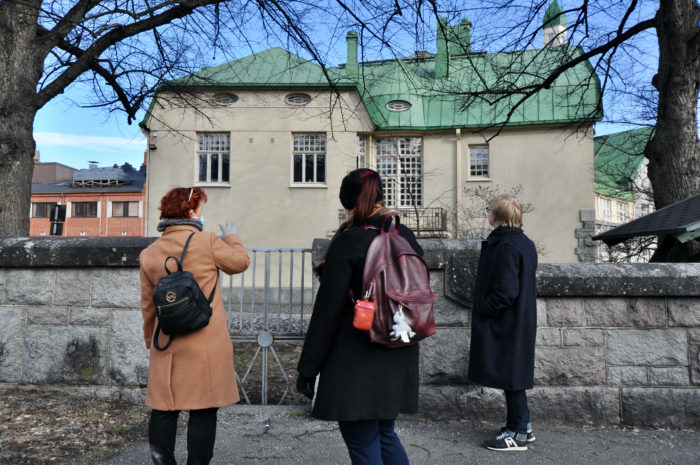
Eila Lokka, left, introduced freelance journalists to the jugend / Art Nouveau architecture of Tampere, Finland. The central fire station, built in 1908 was designed by Wivi Lönn. Photo: Tuomas MacGilleon
As a researcher, Annaliina Niitamo is particularly interested in city infrastructure and planning, and how these take (or do not) into consideration the needs of pedestrians. She points out that this is no small matter: Walking is a way to be a part of the city, procreate public space and enable spontaneous encounters.
“The possibility to spend time in public spaces is vital for a modern, democratic city. Walking is a way to be a part of the city community, even if it might be distant and anonymous. Exploring the city builds empathy and helps us to understand ourselves and others.”
In Graz, Austria, a group of women recently did just this.
Sharing utopias and learning from each other
In the Active Urban Citizenship project, thirteen women with diverse backgrounds explored an urban district by walking around in small groups and reflecting on what they saw.
During these city walks, the participants were asked to identify what they liked and did not like about the specific district, as well as think of how they would like to improve it. While walking, they took photos of places which were of importance to them.
The women then discussed the photos, their ideas and their utopias in workshops, developing ideas for active citizenship to promote change in the district. Together with artists Maryam Mohammadi and Kate Howlett-Jones, they also created a photo exhibition which was presented in shop windows.
A part of the Graz Kulturjahr 2020, the Active Urban Citizenship project was organized by the University of Graz in cooperation with the local NGO Frauenservice Graz.
As we walk, we constantly scan our surroundings, looking for hints of anything that might affect us
Dr Brigitte Kukovetz, who was part of the research team, says that the project broadened the horizons of the participants.
“They learned about public places, how to argue their own skills and needs. They also learned from each other and took ownership of the city regardless of their legal status,” she says.
Being asked to contribute to city development, the project also sparked a civic learning process. Dr Kukovetz says that this applied especially to the people who were otherwise often left out of decision-making processes.
“What we observed was that in small groups the women were enabled to make active contributions, especially true for those who were not fluent in German. The project expanded their personal agency and had an empowering effect.”
Learning by and from walking
Walking can be a part of a learning experience, but it also promotes learning on its own.
As we walk, we constantly scan our surroundings, looking for hints of anything that might affect us. Annaliina Niitamo explains that walking forces us into a subjective learning process. If a particular place seems crowded, we look for a less crowded route. Coming across a dodgy-looking dark alley is likely to have the same effect.
In time, we begin to know intuitively what is a good place for a quiet and relaxing stroll on a weekday afternoon and which places to avoid during a weekend night.
“This kind of urban place learning is different to explicit knowledge. In his book Learning the City, Colin McFarlane speaks of tacit knowledge”, Annaliina Niitamo says.
According to her, finding pleasant, safe and stimulating walking routes in Helsinki is too often the responsibility of the residents of the city. How to bring this tacit knowledge into planning and decision-making is also a tricky question, as gathering rich qualitative data for the use of planning takes up time and resources.
However, she says, this would be worthwhile, as talking about specific places brings up experiences and issues in everyday life in a very different way than answering a questionnaire.
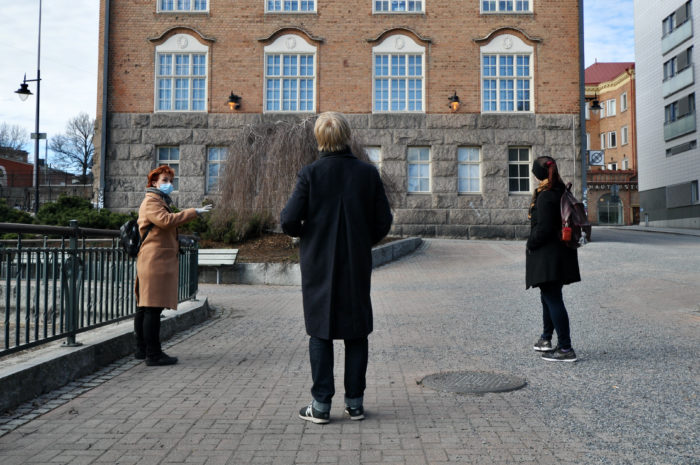
Forced to stop and look at familiar buildings, one can began to notice new details in them and develop a stronger emotional connection to the city. Photo: Tuomas MacGilleon
“During development projects, the city planners could actually go out for a walk with residents representing a diverse group: for example seniors, children, stay-at-home parents as well as people in marginalised positions in traditional planning processes such as non-Finnish speakers and people in disadvantaged social-economic situations”.
Connecting people of different places and times
My walk around Tampere is drawing to a close.
In addition to the obvious health benefits, I feel that I have gained a lot more from the walk. Forced to stop and look at familiar buildings, I began to notice new details in them and develop a stronger emotional connection to the city.
The fire station, for example, was made for horse carriages.
I think of a fire brigade saddling up and dashing out to extinguish a fire in one of the numerous neighborhoods full of wooden houses, built much too close to each other, and get a distant sense of what life might have been like more than a hundred years ago.
Now a fire truck reverses carefully into the building, leaving a few inches between the doorway and the vehicle.
Remarkably, the fire station still serves its original purpose. The city around it has certainly changed, not to mention the life we live in it.
Horse carriages have been replaced by cars, buses and trams. Construction work is going on everywhere, as the city is growing both sideways and upwards.
Reflecting the changes that have taken place in working life and the standard of living, traditional factories have been demolished or renovated to become offices, restaurants and trendy apartments.Walking around this afternoon, I have been able to suck in all of this.
This is our city, and it has been that for many before us.
